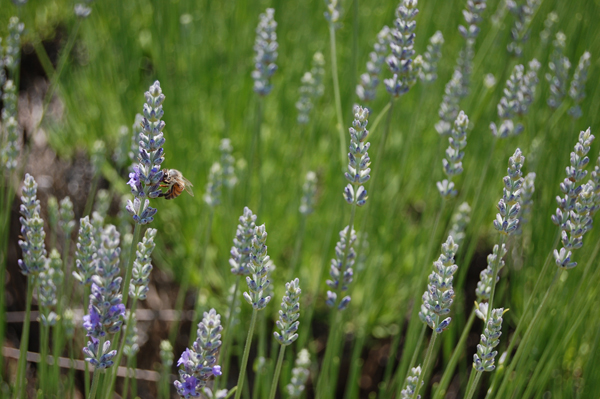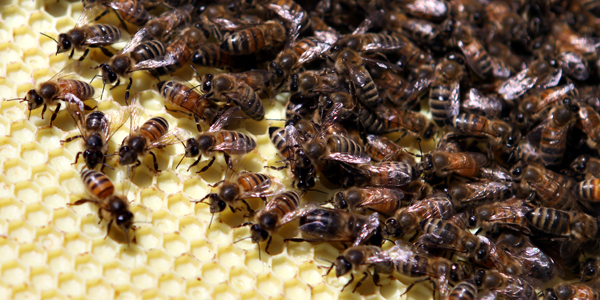
“If the bee disappears from the surface of the earth, man would have no more than four years to live.” —Albert Einstein
This often-used quote is likely mythical. (No hard evidence exists linking Einstein to the quote, other than massive repetition. After all, Einstein was a physicist not a biologist.) That being said, it does make a conceivable point. Some might call the disappearing bee theory dramatic and apocalyptic. Others might wholeheartedly agree with the thought on the relationship between the health of the bee community and our time on earth. Whichever side of the great bee debate you find yourself on, it seems fair to say everyone can agree on one point: Bees – particularly the social varieties — are a crucial element to the cycle of life, and the human diet.
Take the honey bee, for example. Its life is spent gathering nectar from plants, traveling from one to the next, and in turn pollinating that plant community. The act supports agriculture’s version of fertilization. They also collect, store, and process their collected nectar to make honey. We depend on the plants they pollinate to be prolific and the quantities of honey they produce to be high, so we can feast on the fruits of their labor. According to the USDA, bee pollination is responsible for $15 billion in annual added crop value. Considering our diet’s dependence on honey, fruits, vegetables, and livestock that eats pollinated crops, the livelihood of the bee community is something that rightfully calls for our attention.
Beekeepers, those who keep and maintain hives, are part of a centuries’ old practice. Minnesotans are no strangers to the art of beekeeping and honey gathering; the roots in this state are deep and strong. In 1907 the Horticulture Society of Minnesota founded the Minnesota Beekeepers Association (renamed the Minnesota Honey Producers Association in 1981). Right now the local beekeeping community is literally buzzing. A web of beekeepers exists in Minnesota and its neighboring states. Minnesota has matured into a nationwide leader in honey production. In 2009, the state was the sixth-highesthoney producer in the country, behind Florida, Montana, California, South Dakota, and North Dakota (consistently the highest producer). “The lead honey producers, in terms of amount of honey produced per colony, produce a lot of honey only because they have lots of beekeepers, but per colony their production is much lower than in the Upper Midwest. We still have lots of clover, alfalfa for the bees — at least more than in other states,” says Dr. Marla Spivak, professor of apiculture and social insects at the University of Minnesota.

A new style of beekeeping has emerged over the last decade: that of the urbanite. Urban beekeeping has become a popular trend in larger cities like Chicago, San Francisco, and New York City. The urban beekeeping culture exists in Minnesota as well. April 24 will mark the one-year anniversary of the lifted beekeeping ban in Minneapolis. After 34 years of an unmentionable underground beekeeping culture, city residents are now able to participate, legally, in backyard beekeeping and honey gathering, just like their St. Paul counterparts have been doing for more than 20 years. The Minneapolis terms: obtain a permit from Minneapolis Animal Care & Control, pay a $100 annual initiation fee and a $50 annual fee thereafter, keep a flyway barrier – wall, fence, or dense vegetation – at least six feet tall, and gain consent from neighbors (all adjacent neighbors as well as 80 percent of owners within 100 feet for city lots, and 80 percent of owners within 250 feet if you live on more than four acres).
Urban beekeeping gives local city dwellers a feasible option to support local agriculture, regardless of their plot size limitations. “The only differences between urban and rural beekeeping are in the ordinances,” says Spivak. “Fewer colonies can be kept in one location in the city versus the country, but the beekeeping management practices are the same.”
Unfortunately, as of late the entire beekeeping community has been faced with a new challenge. Since 2006 the national bee population has been dying off at an alarming rate. Like the rest of the country, Minnesota has fallen victim. Between 2008 and 2009, statewide honey production decreased by 17 percent. This sudden die-off trend has been largely attributed to Colony Collapse Disorder (CCD). According to Spivak, the symptom of CCD is a relatively sudden loss of adult bees in a colony, leaving behind the queen, some young adults, children, honey, and pollen. The cause behind the missing adult bees has yet to be identified.
If colonies aren’t being lost to CCD, they are to other unknowns. According to Spivak, general colony loss (a loss of bee colonies asymptomatic of CCD) has been increasing over the last three decades. “Before the 1980s, beekeepers would lose an average of 10 percent of their colonies every year. In the 1990s, it was 20 to 25 percent. In the last 5 years, it has jumped to over 30 percent,” she says. She accounts CCD as the cause for one-third of general colony loss.

Spivak gives three reasons for the disappearing act. “First, there are simply not enough flowers that bloom over the length of the growing season in our agricultural and urban landscapes to support bees’ nutritional needs. Second, many of the flowers that bees encounter are contaminated with pesticides. Bees are sweeping the environment to eat and are picking up every insecticide, herbicide, and fungicide that we apply to crops, home gardens, roadsides. As recent research is showing, these pesticides, alone and in combinations, can be toxic to bees. The third problem is that bees have their own diseases and parasites that weaken them, and the combination of diseases, malnutrition, and pesticides leads to collapse.”
Doug Schulz (below), Head Bee Wrangler at Wisconsin Natural Acres, has not witnessed CCD in any of his colonies. Over the winter, he did see a loss of beehives on par with Spivak’s averages – 25 percent in 2009. Unlike the head honchos of honey, Schulz’s operation is artisanal. “I manage the hives the way they were managed in the late 1800s / early 1900s: No chemicals, very little travel with the bees, and I take care of the bees like they are my friends. I attribute the survival rate to letting the honey bees consume their own honey, not fructose corn syrup. We also work very hard to keep our bees away from the spraying of pesticides and insecticides.”

Schulz believes the CCD phenomenon is due to a variety of factors. A major issue is chemical dependence and the increased use of pesticides and insecticides. He is especially fearful of the new Roundup Ready Corn, and the potential detrimental effects of its large-scale use in the Upper Midwest. “I do not like to say this; however, I do not believe the situation will get any better for the honey bee over the next several years due to the new type of chemicals being sprayed on corn, alfalfa, soybeans, etc. for insect and weed control,” he says. “I am quite concerned the situation will get worse due to this.”
Recently the University of Minnesota was one of 17 institutions awarded a grantto study the causes of CCD and develop bees that can resist disease. Spivak is one of 20 funded collaborators who will work at achieving these goals through 2012. In doing so, they also hope to increase the genetic diversity of the bee population. The information they gather will be used to educate the public about best beekeeping practices.
Not a researcher? There are other ways to help. An increase in local beekeeping, both urban and rural, might support the fight against the great bee die-off. A rise in the local honey bee population would help maintain, or perhaps, increase, pollination and sustainability of local flora. If you live in Minneapolis or St. Paul and are interested in releasing your inner beekeeper, be sure to obtain your permit from Animal Control before you begin. Many local resources exist for the hobby beekeeper to get started or continue their education. In order to keep an organic colony, try not to use chemical treatments unless they are a last resort. Although antibiotic and pesticide residues that honey bees transfer from nectar to honey are very low or nonexistent, the chemicals they pick up from local plants, gardens, and golf courses can be harmful to the bees. Another consideration is what type of bee you will keep. Spivak and an associate have spent more than a decade breeding a Hygienic Bee that can sniff out diseased brood and remove it from the colony, thus eliminating infection and infestation. These bees are available at local beekeeping supply companies.
Spivak describes a utopian environment for bees. “There would be a two-mile radius with flowers that bloom from April through September — no pesticides applied in that area. The flowers would include early blooming trees like willow, maple, and oak, which would provide pollen for bees in early spring. There would be lots of apple trees and wild mustard plants. There would be honey locust trees, then acres and acres of clover and alfalfa, lots of native blooming flowers like hyssop, monarda (anything in the mint family), basswood trees to bloom in midsummer, finally ending in acres of goldenrod and asters in late summer and early fall. Bees would be in heaven in that environment.”

I am trying 2 top bar hives on my 2nd floor porch this year. I got interested in trying bee keeping after seeing the articles on Heavy Table last year. I pick my bees up this afternoon at Nature’s Nectar & install them in the hives this evening-wish us luck!!!
Good luck Josie! Keep us posted.
Good luck with that. I’d love to keep some bees. I’ll have to do some research
I remember hearing that cell phone towers were compounding the problem by interfering with bees’ ability to navigate to and from their hives, yet there’s no mention of it here. Just curious if this is still a viable ‘theory’ or if it’s been debunked? Or perhaps the telecomm companies have successfully buried it? ;)
I too heard that Cellphone usgage is causing disruptionto the bes and may eventually lead to their extinction.
Mike and Rashmi,
Thanks for bringing this up. According to Spivak, the cell phone theory is merely a rumor and was debunked shortly after being brought up.
Alyssa
Glad to hear it, Alyssa. I didn’t like the bees’ chances against cell phones if it came to that.
Here’s hoping for a more sporting fight against pesticides & the like.
Thanks for the response! Great piece!
Thanks guys! It went ok-one of the queens escaped, & I am going to have to order another one, but the other package installed without a hitch. I got stung once immediately, & then not again. The bees seemed pretty docile, even with all the commotion associated with hiving them. I have high hopes for the bees!!!
Define foodie, there is a wealth of information on the interwebs! I started with the Heavy Table piece last fall, & went from there. Go for it!
Another way to “keep” bees, is simply to plant lots of flowers or flowering trees/shrubs. Keep the chemicals off of your yard and you’ll be surprised on how many bees you’ll see.